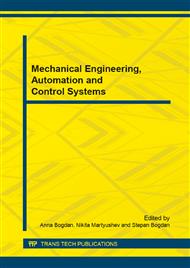[1]
Mishra R.S., Ma Z.Y. Friction stir welding and processing, Materials Science and Engineering: R: Reports. 50, 1–2 (2005) 1–78.
DOI: 10.1016/j.mser.2005.07.001
Google Scholar
[2]
J. Stephen Leon, V. Jayakumar. Investigation of mechanical properties of aluminium 6061 alloy friction stir welding, American Journal of Mechanical Engineering and Automation. 1, 1 (2014) 6-9.
Google Scholar
[3]
R. Nandan, R. DebRoy. Bhadeshia Recent Advances in Friction-Stir Welding Process, Welding Structure and Properties, Progress in Material Science. 53 (2008) 980-1023.
DOI: 10.1016/j.pmatsci.2008.05.001
Google Scholar
[4]
L. E. Murr, G. Liu, J. C. McClure. Dynamic recrystallization in friction-stir welding of aluminium alloy 1100, Journal of materials science letters. 16 (1997) 1801-1803.
Google Scholar
[5]
J.A. Schneider, A.C. Nunes. Characterization of Plastic Flow and Resulting Microtextures in a Friction Stir Weld, Metallurgical and Materials Transactions B. 35 (2004) 777-783.
DOI: 10.1007/s11663-004-0018-4
Google Scholar
[6]
M. W. Mahoney, C. G. Rhodes, J. G. Flintoff, R. A. Spurling and W. H. Bingel. Properties of Friction-Stir-Welded 7075 T651 Aluminum, Metall. Mater. Trans. A. 29A, 7 (1998) 1955-(1964).
DOI: 10.1007/s11661-998-0021-5
Google Scholar
[7]
S. Kahl. The influence of small voids on the fatigue strength of friction stir welds in the aluminium alloy AA6061-T6, HERON. 55 (3 / 4), 223 (2010).
Google Scholar
[8]
V.I. Pavlova, E.A. Alifirenko, E.P. Osokin. Voprosi materialovedeniya. 60 (4), 74 (2009). (in Russian).
Google Scholar
[9]
S.Y. Tarasov, A.V. Kolubaev. Generation of shear bands in subsurface layers of metals in sliding, Physics of the Solid State, 50, 5 (2008) 844-847, (2008).
DOI: 10.1134/s1063783408050077
Google Scholar
[10]
Hua-Bin Chena, Keng Yan, Tao Lin, Shan-Ben Chena, Cheng-Yu Jiang, Yong Zhao. The investigation of typical welding defects for 5456 aluminum alloy friction stir welds, Materials Science and Engineering A 433 (2006) 64–69.
DOI: 10.1016/j.msea.2006.06.056
Google Scholar
[11]
Kolubaev, S. Tarasov, O. Sizova, E. Kolubaev, Scale-dependent subsurface deformation of metallic materials in sliding, Tribology International. 43, 4 (2010) 695–699.
DOI: 10.1016/j.triboint.2009.10.009
Google Scholar
[12]
V.E. Rubtsov, A.V. Kolubaev. Effect of heat generation due to plastic deformation on behavior of surface-layer material during sliding, Journal of Friction and Wear, 30, 5 (2009) 324-328.
DOI: 10.3103/s1068366609050043
Google Scholar
[13]
M. Maeda, H. Liu, H. Fujii, T. Shibayanagi. Welding in the World, 49, 3/4 (2005) 69-75.
Google Scholar


